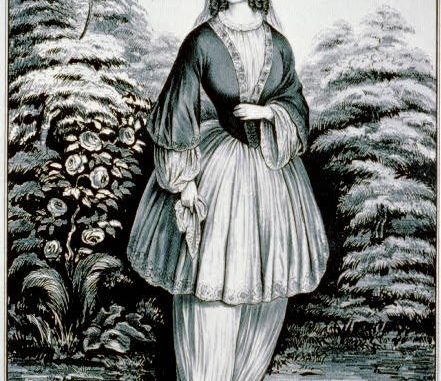
Women’s Suffrage Series
By CHERRY SOKOLOSKI/Special Contributor
The mid-19th century was full of reform movements in the United States, and women were involved in many of them.
One such reform effort involved women’s dress. The conventional dress of the times included about 10 pounds of muslin petticoats, starched shirtwaists and tight corsets that actually squeezed internal organs and bruised ribs, plus long skirts that dragged in the mud as the suffragists went about their grueling speaking circuits.
In the early 1850s, the New Dress for women appeared. Consisting of a short dress over baggy trousers, the outfit was pioneered by Elizabeth Cady Stanton’s cousin, Libby Smith Miller, who designed it to use while gardening. Stanton and her neighbor, Amelia Bloomer, copied the fashion, and Bloomer advocated for the new dress in her newspaper, the Lily, in 1852.
The outfit thus came to be known as the “Bloomer Costume.”
The Lily was primarily a temperance newspaper, but the article about the bloomers drew a huge audience. In fact, the newspaper’s circulation grew from 500 per month to a whopping 4,000 because of the controversy. “I stood amazed at the furor I had unwittingly caused,” Bloomer said. “As soon as it became known that I was wearing the new drew, letters came pouring in upon me by the hundreds from women all over the country, making inquiries about the drew and asking for patterns.”
Stanton loved the new costume. She wrote in her autobiography, “Like a captive set free from his ball and chain, I was always ready for a brisk walk through sleet and snow and rain, to climb a mountain, jump over a fence, work in the garden.”
While the reform-minded women enjoyed their new freedom, their new outfit attracted considerable scorn and ridicule. The suffragists already endured plenty of criticism, but now men and boys stopped to stare at them, whistling and making rude remarks. The resemblance of the pants to blousy Turkish trousers didn’t help, since they were associated with Turkish harems and prostitutes.
Even family members were embarrassed by the bloomers. Stanton’s husband Henry hated seeing his wife in this “short” dress, even though it fell four inches below the knee. He thought that when she and her friends sat on stage at conventions their legs would be exposed, despite the fact that they were also wearing pants.
Men in the audience, said Henry Stanton, could tell “whether their lady friends have round and plump legs, or lean and scrawny ones.”
Elizabeth also got negative reviews from her young son, who was in boarding school. Missing his mother, he implored her to visit him – as long as she left her bloomers at home.
Before long the bloomer costume became a distraction from the message of women’s rights, and by 1854 most women had lengthened their skirts again.
Susan B. Anthony, who was late in adopting this new dress, was also the last to abandon it. She defended the outfit by saying, “Women can never compete successfully with men in various industrial vocations in long skirts.” She was angry at her friends who bowed to criticism, arguing that the “mental crucifixion” they endured because of the bloomers prepared them for the difficult work of freeing women from oppression.
But finally, Anthony acquiesced as well, spending the rest of her life in long dresses of gray or black. In later years she donned a red shawl, donated by suffrage supporters, and the shawl became a badge of sorts for this stubborn suffragist.
Women would have to wait many more decades before their accepted dress became less cumbersome and constricting. But bloomers, for their part, went the way of animal skins and grass skirts.
Sources: Votes for Women by Winifred Conkling, 2018; Great Women of the Suffrage Movement by Dana Meachen Rau, 2006; National Park Service.
Support Northern Colorado Journalism
Show your support for North Forty News by helping us produce more content. It's a kind and simple gesture that will help us continue to bring more content to you.
BONUS - Donors get a link in their receipt to sign up for our once-per-week instant text messaging alert. Get your e-copy of North Forty News the moment it is released!
Click to Donate
